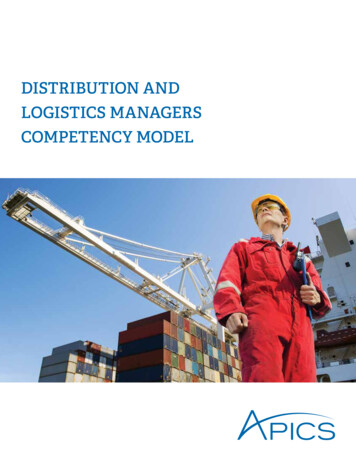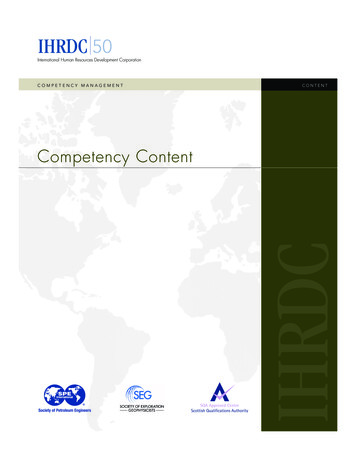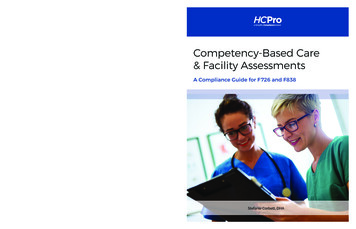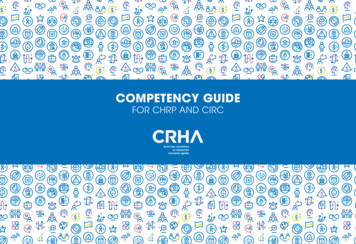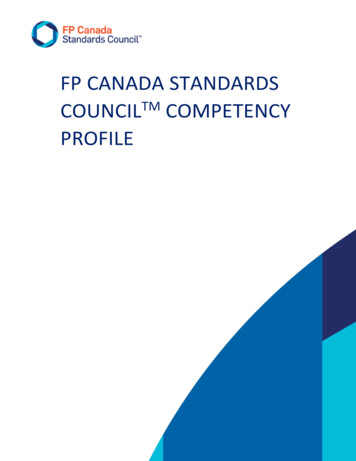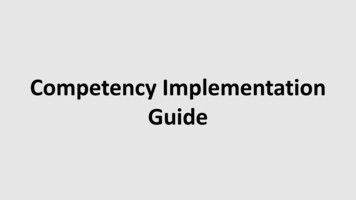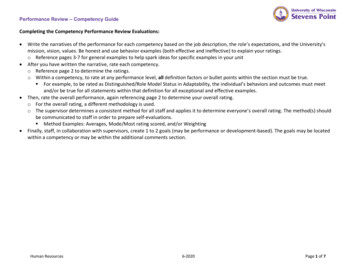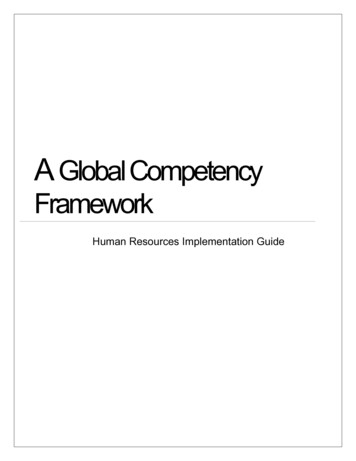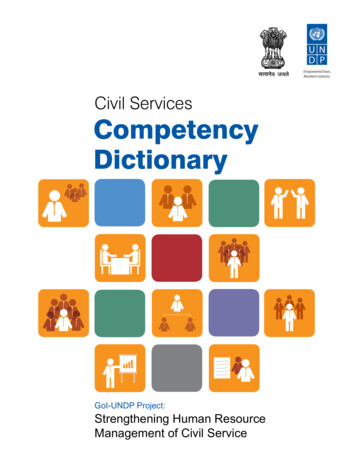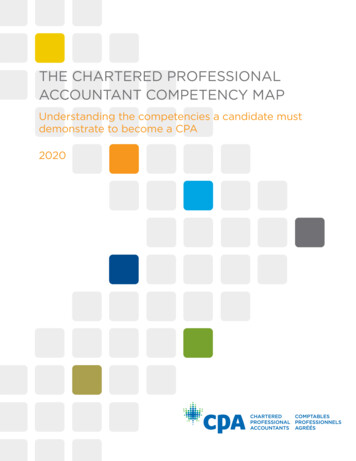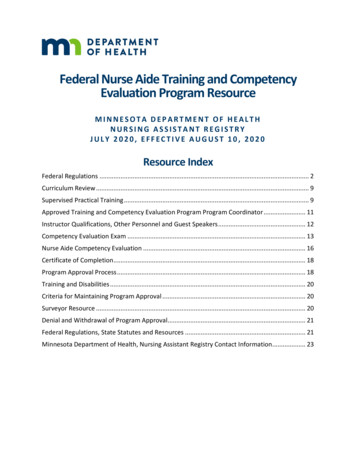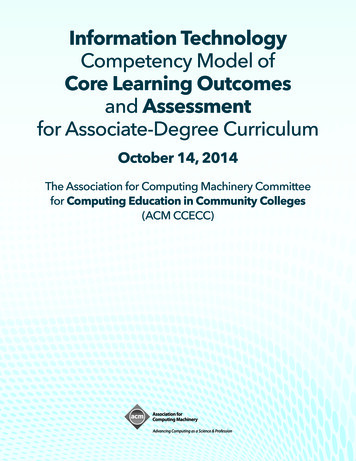
Transcription
Information TechnologyCompetency Model ofCore Learning Outcomesand Assessmentfor Associate-Degree CurriculumOctober 14, 2014The Association for Computing Machinery Committeefor Computing Education in Community Colleges(ACM CCECC)
Information TechnologyCompetency Model ofCore Learning Outcomes and Assessmentfor Associate-Degree CurriculumOctober 14, 2014The Association for Computing Machinery Committee forComputing Education in Community Colleges(ACM CCECC)
Information TechnologyCompetency ModelACM Competency Model of Core Learning Outcomes and Assessment forAssociate-Degree Curriculum in Information TechnologyOctober 14, 2014Produced by theACM Committee for Computing Education in Community Colleges (CCECC)Elizabeth K. Hawthorne, PhDRobert D. CampbellCara Tang, PhDCindy S. TuckerJim NicholsIn Collaboration WithAcademic and Industry Advisors and Reviewers
Information Technology Competency ModelCopyright 2014 by ACMAll rights reserved.Copyright and Reprint Permissions: Permission is granted to use these curriculum guidelines forthe development of educational materials and programs. Other use requires specificpermission. Permission requests should be addressed to: ACM Permissions Dept. atpermissions@acm.org.ISBN: 978-1-4503-3918-6DOI: 10.1145/2686614Web link: http://dx.doi.org/10.1145/2686614ACM Order Number: 999140Cover art by Robert VizziniPrinted in the United States of America
Table of ContentsIntroduction 1 Charge and BackgroundSub-disciplines of Computing as defined by ACMACM/IEEE-CS 2008 Curriculum Guidelines for Undergraduate Degree Programs inInformation TechnologyU.S. Department of Labor Information Technology Competency ModelLearning OutcomesAssessment of Learning OutcomesBusiness ContextIT as a Service DisciplineInternational Sphere of ApplicabilityMathematics ProficiencyAffiliated CourseworkHow to Use this Competency-based Curricular Guidance .7 Competency-based Learning and Competency Models U.S. Department of Labor Information Technology Competency Model Software Engineering Institute Software Assurance Competency ModelConducting Program Reviews to Update and Create CurriculumCreating Program OutcomesFacilitating Program and Course ArticulationEstablishing Authoritative Source for Program and Institutional AccreditationMapping Industry Certifications and AcademiesComplying with Government-sponsored FrameworksInteracting with Local Advisory BoardsCrafting Course and Program AssessmentsDesigning Placement and Challenge TestingCAP Space – Curriculum, Assessment and PedagogyBody of Knowledge . .11 Technical Competency Areas and Workplace SkillsAssessment MetricsACM Core IT Learning Outcomes with Three-Tiered AssessmentACM Core IT LOs Mapped to Other Curricula, Classifications, and Frameworks . 25 U.S. Department of Labor Information Technology Competency ModelKnowledge Units of the ACM/IEEE-CS 2008 Curriculum Guidelines forUndergraduate Degree Programs in Information TechnologyCSTA Standardsi
ACM Computing Classification SystemABET CAC Criteria for Information Technology ProgramsThe European Union e-Competence FrameworkCommon Criteria for Information Technology Security EvaluationNICE Framework 2.0Bibliography . . . .29Appendix A: Committee’s Charge and Process . . . 31Appendix B: Participants and External Reviewers . . . . .32Appendix C: Bloom’s Revised Taxonomy . . .36Appendix D: Curriculum Champions . .39Appendix E: ACM Core IT Learning Outcomes . . .40Appendix F: Certificate and Degree Program Correlations . . . .42 Bay College, MichiganBluegrass Community and Technical College, KentuckyBroward College, FloridaEstrella Mountain Community College, ArizonaKapi'Olani Community College, HawaiiManor College, PennsylvaniaNorth Seattle College, WashingtonPortland Community College, OregonSitting Bull College, North Dakotaii
List of TablesTable 1: ACM Core IT Learning Outcomes . 12Table 2: ACM Core IT Learning Outcomes with Three-tiered Assessment. 14Table 3: Bay College Program Correlation . 44Table 4: Bluegrass Community and Technical College Program Correlation . 49Table 5: Broward College Program Correlation . 54Table 6: Estrella Mountain Community College Certificate Correlation . 58Table 7: Kapi’olani Community College Program Correlation . 64Table 8: Manor College Program Correlation . 70Table 9: North Seattle College Program Correlation . 75Table 10: Portland Community College Certificate Correlation . 79Table 11: Sitting Bull College Program Correlation . 84List of FiguresFigure 1: ACM Core IT Learning Outcomes Distribution across Bloom's Levels . 3Figure 2: CAPSpace.org . 10Figure 3: Mappings of ACM Core IT Learning Outcomes to Other Curricula, Classifications andFrameworks . 25Figure 4: Active Learning Verbs of Bloom's Revised Taxonomy . 38Figure 5: Certificate and Degree Program Correlations with ACM Core IT Learning Outcomes. 42iii
IntroductionCharter and BackgroundThe ACM Committee for Computing Education in Community Colleges (CCECC), at the directionof the ACM Education Board, convened a task force to produce curricular guidance forassociate-degree programs in Information Technology. In fulfilling its charge (Appendix A), theCCECC identified the body of knowledge as a set of fifty student learning outcomes thatconstitute core Information Technology (IT) competencies for all IT-related associate-degreeprograms. These learning outcomes were created with the intent of being adaptable, notoverly technology specific, and to remain current for the foreseeable future. Furthermore,these core IT learning outcomes were primarily influenced by: current and future needs of business and industry, professional and industry certifications, government and standards bodies, and related-IT curricula, including the ACM/IEEE-CS Curriculum Guidelines for UndergraduateDegree program in Information Technology, and the U.S. Department of LaborInformation Technology Competency Model.The fifty student learning outcomes span the first three levels of Bloom’s Revised Taxonomy(Appendix C), and each outcome is accompanied by a three-tier assessment rubric that providesadditional clarity and a measureable evaluation metric. In Appendix E, these core IT learningoutcomes are correlated to existing courses in degree and certificate programs at severalcommunity and technical colleges nationwide. The growing collection of correlations fromother colleges is viewable online at www.capspace.org/ITcorrelations/.This report represents a significant evolution in curricular guidance, but also stands on theshoulders of and builds upon two previous IT-related curricular reports produced by thiscommittee through the decades: 1) Guidelines for Associate-Degree Programs to SupportComputing in a Networked Environment (Klee, Austing, Campbell, Cover, & Currie Little, 2000),and 2) Computing Curricula Guidelines for Associate Degree Programs (Klee, Austing,Impagliazzo, Currie Little, & Chlopan, 1993).The Sub-Disciplines of Computing1
ACM currently categorizes the overarching discipline of computing into five defined subdisciplines (ACM, 2005) : computer science, computer engineering, software engineering,information systems and information technology. This report specifically focuses oninformation technology defined by the ACM CCECC as follows:Information Technology involves the design, implementation and maintenance oftechnology solutions and support for users of such systems. Associated curricula focuson crafting hardware and software solutions as applied to networks, security, clientserver and mobile computing, web applications, multimedia resources, communicationssystems, and the planning and management of the technology lifecycle (ACM CCECC,2009).ACM/IEEE-CS 2008 Curriculum Guidelines for Undergraduate Degree Programs in InformationTechnologyACM and its partner professional societies have jointly produced significant volumes ofcurricular recommendations and guidelines for baccalaureate computing programs, knowncollectively as the ACM Computing Curricula series (ACM, 2014). Among these is the publicationIT 2008: Curriculum Guidelines for Undergraduate Degree Programs in Information Technology(ACM & IEEE-CS, 2008). This work was one of many sources that influenced the curricularguidance outlined in this report.U.S. Department of Labor Information Technology Competency ModelAt the direction of the United States Department of Labor, the Employment & TrainingAdministration has produced a comprehensive competency model for the InformationTechnology industry. The Information Technology Competency Model identifies the knowledge,skills, and abilities deemed necessary for workers to perform successfully in the field of IT. Thiswork was one of many sources that provided a foundation for the curricular guidance outlinedin this report (U.S. Department of Labor, 2012).Learning Outcomes2
The ACM CCECC used a customized version of Bloom’s Revised Taxonomy (Appendix C) informulating student learning outcomes. For each level, a well-defined collection of measurableaction verbs is specified. The active learning verbs chosen for the core IT competencies wereselected from the first three levels of Bloom’s Taxonomy: “remembering”, “understanding”,and “applying.” These are frequently augmented by higher Bloom’s levels in the “highlydeveloped” column of the associated assessment rubric. The distribution of core ITcompetencies by Bloom’s level appears in Figure 1. Depending upon the way one organizes thelearning outcomes into an associate-degree or certificate program, higher Bloom’s levels can beincluded to meet local needs as appropriate to the specific IT program.Figure 1: ACM Core IT Learning Outcomes Distribution across Bloom's LevelsFor an interactive mapping of the core IT competencies to Bloom’s Revised Taxonomy visitwww.capspace.org/ITmappings/ and select the Bloom’s Taxonomy option from the dropdownmenu.Assessment of Learning OutcomesIn formulating assessment rubrics, The ACM CCECC uses a structured template comprised ofthree tiers: “emerging”, “developed”, and “highly developed.” Typically as the level of studentachievement progresses from “emerging” to “highly developed”, the level of Bloom’s verbs alsoincreases from the lower order thinking skills (LOTS) to the higher order thinking skills (HOTS),including “analyzing” and “evaluating.”3
The cognitive outcomes associated with the core IT competencies reflect technical domains,including client computing and user support, databases and information management, digitalmedia and immersive technology, networking and convergence, programming and applicationdevelopment, servers, storage and virtualization, and security and information assurance. Thetargeted knowledge in these domains comprises the majority of the learning outcomes in thisreport. Student competencies constituting affective outcomes typically assess studentdemonstration of workplace soft skills, such as professional behavior and business awareness,ethical conduct, and the social awareness of the impact of technology. Given the ubiquity ofcomputing technologies across a global society, ethical behavior and adherence to codes ofconduct for computing professionals is imperative; therefore, careful consideration of legal,ethical, and societal issues involving computing, the Internet, databases, property rights andprivacy concerns are essential to the education of computing professionals. These highlysought-after behaviors and attitudes are also included as part of the learning outcomes in thisreport.Business ContextStrongly influenced and championed by several IT industry task force members and fashionedwith direct input from business leaders, the core IT competencies are reflective of thefoundational knowledge and technical skills desired by employers. In addition to ensuring ITcompetencies are associated with enterprise scenarios reflective of business mission and goals,learning outcomes also include workplace and personal effectiveness competencies, such asbusiness awareness, communication skills, collaboration and teamwork, and ethics andprofessional behaviors. With the persistent global demand for computing professionals and therealized benefits of a diverse workforce, the core IT learning outcomes include an awareness offuture workforce and technology trends, such as broadening participation in computing andreviewing emerging technologies, and their related impact on the future of computing.IT as a Service DisciplineThe ACM CCECC has long recognized the “computing for other disciplines” notion, first codifiedfor associate-degree programs in its 1993 multi-volume curriculum report – Computer SupportServices, Computing and Engineering Technology, Computing for Information Processing,4
Computing Sciences, and Computing for Other Disciplines (COD). As stated in the COD volume,“Throughout the evolution of computing education, no organization supported a report withrecommendations specifically addressing courses for other disciplines. The present report is thefirst to make such recommendations” (Klee, Austing, Impagliazzo, Currie Little, & Chlopan,1993). Two decades later information technology has become interdisciplinary and is anintegral part of every field of study and every profession. The idea of “IT as a service discipline”is as equally important as other disciplines that provide students with skillsets (e.g., statisticalanalysis or scientific method). The collection of core IT competencies contained in this currentguidance provides a relevant example with the inclusion of learning outcomes related to digitalmedia, where the distinctions between the tools themselves (IT artifacts), the use of the tools(IT skills) and the application of the tools (artworks) may challenge computing educators in thedesign of effective curriculum and assessment methods. Such is the extraordinary,interdisciplinary nature of the field of IT.International Sphere of ApplicabilityThe curricular resources made available by the ACM CCECC through CAPspace.org providemeaningful guidance for two-year post-secondary higher education programs in a wide varietyof settings. This is achieved in large measure by defining specific curricular content in terms ofmeasurable student learning outcomes accompanied by detailed rubrics for effectiveassessment of student learning. While some specific implementation aspects of theseresources may be more prominent in the United States, the resources appear in a manner thatmakes them readily applicable to numerous settings and easily adaptable to a wide variety ofimplementation strategies worldwide.In the United States, the American Association of Community Colleges (AACC) reports thatapproximately one-half of all undergraduate college students are enrolled in communitycolleges, typically pursuing a two-year program of study leading to a recognized associatedegree (AACC, 2013). The IT curricular guidance contained herein is applicable to such degreeprograms.Beyond the United States, many countries have post-secondary higher education optionsfeaturing similar programs of study. The AACC underscores this via its Office of International5
Programs and Services whose partnership initiatives between U.S. community colleges andsimilar institutions around the world “support the exchange of best practices, enhance mutualunderstanding between cultures, and expand opportunities for students to gain globalcompetence and skills for the 21st Century” (AACC, 2013).As presented in a reflective interview by McJunkin entitled "The Global Linkage," JamesMcKenney, AACC Vice-President for Economic Development and International Programs, spokeas early as 2002 about the rapidly expanding phenomenon of community colleges, two-yeartechnical colleges, and the two-year structure in general throughout Europe, the Americas andAsia (McJunkin, 2009).Mathematics ProficiencyThe core IT learning outcomes require that students have prerequisite mathematicalproficiency equivalent to intermediate algebra. Higher level courses, such as college algebraand statistics may be necessary for specific IT programs.Affiliated CourseworkRoutinely, programs of study in technical fields include affiliated coursework designed toprovide foundational knowledge in disciplines either prerequisite to or synergistic with theprimary pursuit. In the case of Information Technology, such coursework includes mathematicsand quantitative reasoning as well as written and spoken communication. Additionally, giventhe wealth of settings for IT careers – affiliated coursework may also include topics as farranging as organizational behavior and foundations of business, physics and engineering,humanities and the arts, cultural studies and world languages, and social and behavioralsciences.6
How to Use this Competency-based Curricular GuidanceCompetency-based Learning and Competency ModelsCompetency -based learning also known as outcomes -based learning is different from thetraditional education approach. Instead of focusing on how much time students spend learninga particular topic or concept (Carnegie unit credit hour), the outcomes-based model assesseswhether students have mastered the given competencies, namely the skills, abilities, andknowledge. Simply stated, outcomes-based learning is not about seat time, but rather aboutwhat students know and what they are able to do (University of Wisconsin System, 2014).In 2012 the U.S. Department of Labor published its Information Technology Competency Model(U.S. Department of Labor, 2012), and in 2013 the Software Engineering Institute published theSoftware Assurance Competency Model (Hilburn, Ardis, Johnson, Kornecki, & Mead, 2013). TheU.S. Department of Education endorsed competency-based programs in March 2013, and ArneDuncan, U.S. Secretary of Education wrote: “We know many students and adult learners acrossthe country need the flexibility to fit their education into their lives or work through a class ontheir own pace, and these competency-based programs offer those features – and they areoften accessible to students anytime, anywhere” (Ed.gov, 2013).Consequently, the contemporary model for constructing curricula in community colleges is anapproach based upon clearly-defined and measureable learning outcomes rather thancollections of topics. Community and technical colleges typically rely on assessment expertsworking hand-in-hand with faculty to integrate sound evaluation metrics at both the course andprogram levels. Consistent with this practice and the ACM Education Board’s charge (seeAppendix A), the CCECC focused on learning outcomes rather than a list of topics in order topromote greater adaptability across institutions and provide much-needed guidance forassessment. A given learning outcome may be addressed in one or more technical domainswithin an IT program, and a given associate-degree or certificate program may organize and usethe outcomes in a manner best suited to their local needs. Topics and instructional methodsremain the purview of individual institutions and their local advisory boards.7
The core IT learning outcomes are itemized in the Body of Knowledge (chapter III) and can alsobe viewed interactively in a variety of formats to facilitate their use for diverse purposes atwww.capspace.org/IT/. Such uses of the student learning outcomes and their associatedassessment rubrics, correlations and mappings include, but are not limited to the following.Conducting program reviews to update and create curriculumFor example, the core IT learning outcomes can be used by colleges to conduct periodicprogram reviews with the intent of validating their existing IT courses, certificates, and degrees,as well as to create new IT curriculum. The growing collection of exemplars correlated to thecore IT learning outcomes makes it easy for colleges to compare and develop new courses,certificates and degree programs in information technology. Actual course and programcorrelations from across the nation are listed in Appendix E and online atwww.capspace.org/ITcorrelations/.Creating program outcomesFor example, 100% of the ACM CCECC learning outcomes for core IT competencies map to theIT Knowledge Units on which the Curriculum Guidelines for Undergraduate Degree Programs inInformation Technology (ACM & IEEE-CS, 2008) were constructed. To view the mapping for theIT Knowledge Units, see www.capspace.org/ITmappings/.Facilitating program and course articulationFor example, the “C-ID Information Systems Faculty Discipline Review Group” in California isusing these guidelines to establish a model curriculum for two-year IT programs with theexpectation of enhancing it to a transfer model curriculum. Another articulation example ismanifested in high schools that adhere to the Computer Science Teachers Association (CSTA)standards. To view the mapping for the CSTA standards, see www.capspace.org/ITmappings/.Establishing authoritative source for program and institutional accreditationFor example, the IT competencies defined by the ACM CCECC have been mapped to theAccreditation Board for Engineering and Technology (ABET) criteria for Information Technology.To view the ABET mapping, see www.capspace.org/ITmappings/.8
Mapping to industry academies and certificationsFor example, institutions currently offering curricula leading to vendor certification fromcompanies such as Microsoft, EMC, Juniper Networks, NetApp, Oracle, Cisco, and CompTIA willsee that the IT core competencies are reinforced across those curriculum frameworks.Complying with government-sponsored frameworksFor example, mappings have been established between the IT competencies and the U.S.Department of Labor Information Technology Competency Model championed by Mid-PacificInformation and Communication Technologies Center (MPICT), Broadening AdvancedTechnological Education Connections (BATEC), and the National Convergence TechnologiesCenter (CTC). To view the mapping for the IT Competency Model, seewww.capspace.org/ITmappings/.Interacting with local advisory boardsFor example, an advisory board at Bluegrass Community and Technical College (BCTC) reviewedthe IT core competencies and compared them to learning outcomes for BCTC’s existing twoyear computing curricula and provided feedback to strengthen the local Computer &Information Technologies program of study.Crafting course and program assessmentsSince this curricular guidance was developed with assessment in mind from the beginning,learning outcomes and evaluation metrics were identified prior to and in lieu of prescribedcourses. As such, this guidance ideally facilitates the creation of a wide range of competencybased evaluations, such as course/program projects and portfolios as well as correspondingrubrics.Designing placement and challenge testingFor example, correlating the courses in a curriculum, with the aid of the assessment rubric forevaluation, readily accommodates the creation of placement tests and challenge exams.9
CAP Space – Curriculum, Assessment and PedagogyIn 2009, CAP Space.org (Figure 2) was established by the ACM CCECC as an interactiverepository of educational resources for associate-degree programs in computing. Today, thecurricular, assessment, and pedagogical resources of CAP Space support educators in thecomputer science, software engineering, computer engineering, and information technologydisciplines. Resources developed specifically for information technology include the following: The full IT report – www.capspace.org/ITreport/ The ACM core IT learning outcomes - www.capspace.org/IT/ The associated assessment rubric - www.capspace.org/ITassessment/ The growing collection of correlation exemplars - www.capspace.org/ITcorrelations/ The online form and instructions for submitting correlations –www.capspace.org/correlation/ The ACM core IT learning outcomes mapped to other curricula, classifications, andframeworks - www.capspace.org/ITmappings/ The active learning verbs of Bloom’s Revised Taxonomy www.capspace.org/BloomsTaxonomy/Figure 2: CAPSpace.org10
Body of Knowledgewww.capspace.org/IT/The fifty learning outcomes represent core competencies that a student in any IT-relatedprogram must demonstrate. The learning outcomes should thus be seen as foundational/corefor any associate-degree IT program, and not as specifying a complete program. Curricula forspecific IT programs (e.g., networking, programming, digital media, and user support) willnecessarily include additional coursework in one or more defined areas of study.The core IT learning outcomes are grouped into technical competency areas and workplace skills.See Table 1.Technical Competency Areas An ability to demonstrate core IT competency in client computing and user support. An ability to demonstrate core IT competency in database and informationmanagement. An ability to demonstrate core IT competency in digital media and immersivetechnology. An ability to demonstrate core IT competency in networking and convergence. An ability to demonstrate core IT competency in programming and applicationdevelopment. An ability to demonstrate core IT competency in servers, storage and virtualization.Workplace Skills An ability to function effectively as a member of a diverse team to accomplish commongoals. An ability to read and interpret technical information, as well as listen effectively to,communicate orally with, and write clearly for a wide range of audiences. An ability to engage in continuous learning, as well as research and assess new ideasand information to provide the capabilities for lifelong learning. An ability to exhibit professional, legal, and ethical behavior. An ability to demonstrate business awareness and workplace effectiveness.11
Table 1: ACM Core IT Learning OutcomesAn ability to demonstrate core IT competency in client computing and user support1Carry out trouble-shooting strategies for resolving an identified end-user IT problem.2Differentiate among various operating systems.3Explain the process of authentication and authorization between end-user devices and computing network resources.4Identify a variety of assistive or adaptive technologies and universal design considerations.5Identify basic components of an end-user IT system.6Implement a hardware and software configuration responsive to an identified scenario.7Summarize life-cycle strategies for replacement, reuse, recycling IT technology and resources.8Summarize strategies to support or train users with their IT resources.9Use a variety of practices for making end-user IT systems secure.An ability to demonstrate core IT competency in database and information management10Describe the data management activities associated with the data lifecycle.11Diagram a database design based on an identified scenario.12Differentiate between public and private data.13Discuss applications of data analytics.14Discuss issues relevant to dealing with very large data sets, both structured and unstructured.15Identify database administration tasks.16Produce simple database queries.17Use data analytics to support decision making for a given scenario.An ability to demonstrate core IT competency in digital media and immersive technology18Differentiate among a variety of technology-based sensory interactions.19Differentiate among data types, data transfer protocols and file characteristics specific to the targeted use.20Illustrate the activities of a digital media design process.21Implement communication principles into digital media design.An ability to demonstrate core IT competency in networking and convergence22Carry out basic computer network troubleshooting techniques.23Describe the layers, protocols and components of the OSI model.24Diagram the components of an integrated IT system.25Differentiate among various computer networking models.26Differentiate among various techniques for making a computer network secure.27Summarize the flow of data through a computer network scenario.An ability to demonstrate core IT competency in programming and application development28Demonstrate best practices for designing end-user computing interfaces.29Demonstrate the techniques of defensive programming and secure coding.30Diagram the phases of the Secure Software Development Lifecycle.31Discuss software development methodologies.32Summarize the differences among various programming languages.33Use a programming or a scripting language to share data across an integrated IT system.34Use a programming or a scripting language to solve a problem.12
An ability to demonstrate core IT competency in servers, storage and virtualization35Differentiate among strategies for business continuity provisioning of
Bluegrass Community and Technical College, Kentucky Broward College, Florida Estrella Mountain Community College, Arizona Kapi'Olani Community College, Hawaii Manor College, Pennsylvania North Seattle College, Washington Portland Community College, Oregon Sitting Bull College, North Dakota
